|
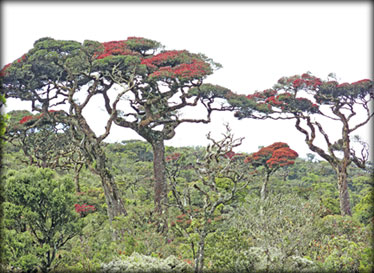
The canopy of trees |
The Nilu in full bloom:
The magical trek to the end of the world
By Mahil Wijesinghe
Having trekked many a time in groups through various forests, I
decided to go it alone this time - a brief and quick walk in the wild to
see Nilu flowers. With an interest in observing the rich biodiversity of
Horton Plains, particularly its floral diversity, I, as a first-time
visitor, made a short trip to the Horton Plains on a chilly day
recently.
All along the rail ride from Haputale to Ohiya, mist threatened to
spoil the trip. It was rainy and misty and even the majestic mountains
in the distance were not visible.
I crossed the Ohiya railway station with a self-appointed guide,
climbed a steep 11 km and walked into the rather welcoming office of the
Wildlife Department to get permits to enter the Horton Plains National
park. From the entrance, another 11 km drive to the main office was an
enjoyable experience.
The vegetation all around was lush and green, and there were richly
coloured flowers on either side of the road. My journey was to take me
through the biodiversity reserve with its endemic flora and fauna, and
home to several rivers, rivulets, waterfalls and pools.
The mountains and plateau kept us company. A herd of sambur crossed
the path. A jungle fowl posed for me. The landscape kept changing with
every turn on the road. Dense evergreen forest patches on mountaintops,
open grasslands dotted with Maha Ratmal bushes and little streams and
pools followed us wherever we went.
|
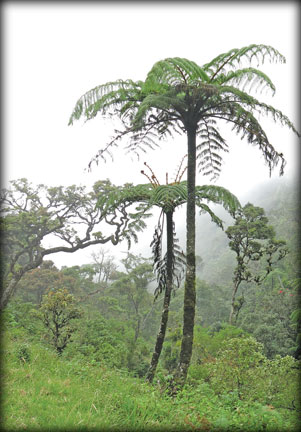
The lush forest |
The skies were grey and the clouds came down to touch us. However, it
was not just the beauty of Nature that fascinated us; it was also the
absolute silence everywhere.
Beautiful scenery
We drove, stopping briefly whenever I came across beautiful scenery
to capture in my camera until we came upon the main office.
The main office of the park was a beautiful building, once home to
Englishman Thomas Farr, who was a keen fisherman and did much to develop
the park, which was built in 1901. It became a rest house in Horton
Plains and was named Farr Inn after Thomas Farr.
The landscape changed again and we saw open grasslands, but the
mountains were still visible. This was the magnificent Horton Plains,
one of the highland’s top attractions. The mountains got closer, as the
canopy of the forest spread around me, almost embracing me in a carpet
of green. In the middle of the green cover was a sea of pink, light
purple and light blue flowers blossoming on both sides of the road. We
stood there for what seemed like an eternity until the mist cleared.
The Horton Plains ‘season’ usually arrives in April with the
blossoming of Binara, Maha Ratmal, Naga Meru Ala, Bovitiya and Kokmota.
However, this time it had arrived early with the blossoming of the
periodic Nilu (Strobilanthes) after 12 years. Of the 28 or more species
of this flower, Horton Plains is the only home to some 20 varieties.
The constant drizzle and heavy fog touching the flowers and the dew
drops spread over the petals added to the beauty of the Horton Plains.
Many in number, the pink flower, one of the finest of the Nilu
species, stood conspicuously and competed with the other varieties in
beauty. Every seventh to 12th year, the jungle paths of Horton Plains
become a mosaic of pink, purple and light blue when Nilu bursts into
bloom in a periodic splendour before it seeds and dies.
In paradise
|

A sight to behold |
Walking through the stretch of Nilu bushes in the Horton Plains, we
felt that we were in paradise. These days, in Horton Plains, especially
in Thotupola Kanda and a part of the Ohiya entrance, the striking beauty
of blossoming Nilu with the vibrant colours of pink, light blue and
purple can be enjoyed.
When these flowers are in full bloom, it is a great time for the
insects and animals in the forest. Hiding through the petals of Nilu
flowers, the bees broke the silence, making a constant buzz while a
colourful jungle fowl was staggering around in a drunken stupor after an
overdose of Nilu nectar.
Besides wooded slopes and Keena trees, open grasslands and the long
stretch of forest, I believe that the charm of the Horton Plains lies in
its misty cover. The mist almost worked as a soundproof wall, for the
silence around was almost deafening. The narrow traffic-free tar road,
which curves, crisscrosses, undulates up and down and becomes narrower,
was a sight to behold.
The Horton Plains, which is 3,150 hectares in extent, was linked to
the European world in the colonial era. Many British colonialists are
commemorated by having landmarks named after them. In 1834, the wild
region was named after a Governor of Ceylon at the time, Sir Wilmot
Horton.
The famous Baker’s Falls at the park is named after Sir Samuel Baker,
who earned his fame as the second-leading killer of elephants during the
colonial time. In 1988, the Horton Plains was elevated to the position
of a national park.
Horton Plains is an exhilarating experience. A land of many moods, it
is a dreamy paradise for genuine nature lovers who look for the eternity
of Nature.
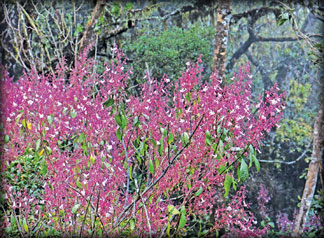 |
 |
 |
| The Nilu flowers in
bloom |
A body of water among
the grassland |
A bee attracted to the
Nilu flower |
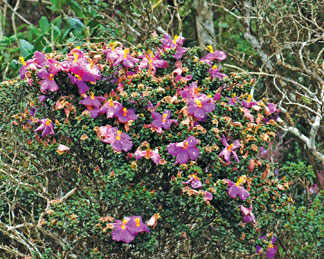 |
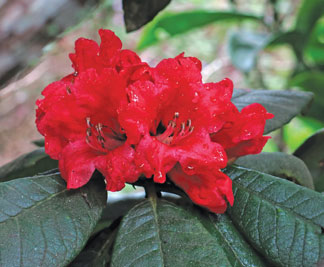 |
| A carpet of purple
flowers |
More beautiful flowers
in the Horton Plains |
|

